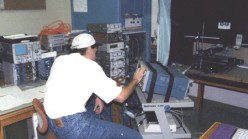Pierre Auger
Faculty:
- Michael Gold - mgold@unm.edu - Professor
- John Matthews - johnm@phys.unm.edu - Professor Director
Post Docs:
- B. (Bernie) R. Becker - bbecker@physics.unm.edu - Post Doc
Graduate Students:
At the University of New Mexico (UNM) we are involved in 2 experiments in neighbouring Utah: the High Resolution Fly's Eye (HiRes) experiment in Dugway Utah, and the Pierre Auger experiment proposed for Millard County Utah and Mendoza Province Argentina. These experiment will be unique in their quality and quantity of data and thus in their potential for physics discovery. These experiments make the U.S. the world center for the study of the highest energy cosmic rays -- one of the most important topics in astrophysics today.
The Pierre Auger experiment combines a 3000km2 ground array and air fluorescence measurements into a hybrid detector. A good visual tour is provided here! The design goal is to accumulate 10s of events >1020eV per year or about 10 times the HiRes experiment at Dugway. The ground array measures the air shower transverse profile; the fluorescence eyes measure the shower longitudinal profile. The hybrid solution provides detailed information on a fraction (10%) of the events plus essential cross calibration between the ground array and fluorescence detectors. Southern and northern hemisphere detectors would permit a sensitive search for anisotropies in the arrival direction of the highest energy cosmic rays. This experiment is approved for a first site in Mendoza Province in Argentina. The US collaborators include: U. of Chicago, U. of Colorado and Colorado State, Fermilab, Louisiana State, U. of Michigan, U. of New Mexico, Pennsylvania State, and U.of Utah. Our UNM group also collaborates closely with the U. of Adelaide (Australia).
At the University of New Mexico we are focusing on fluorescence detector calibration and atmospheric monitoring. Click here for photos of our recent optical calibration source test in Rome. Atmospheric monitoring is particularly critical as the atmosphere is both the calorimeter for the Auger fluorescence detectors and an essential part of the Auger fluorescence detector readout system. For more details see recent cosmic ray notes.
Our goal is to explore the energy spectrum near and above 1020eV; this is equivalent to the energy of a well hit tennis ball but is concentrated in a single subatomic particle or nucleus! The possible sources for such energetic particles are restricted to the most cataclysmic events in the universe or to totally new physics. At these phenomenal energies the cosmic ray interaction on the primordial microwave radiation will limit the observed energies of cosmic rays to about 5 x 1019eV; this is called the Greisen-Zatsepin-Kuz'min (GZK) cutoff. Thus cosmic rays with energies well above the GZK cutoff should originate from sources at distances <50Mpc ( i.e. within the local super cluster of galaxies). For these cosmic rays the deflections in the extragalactic magnetic fields are expected to be modest, about 1-degree for proton primaries, thus the cosmic rays should point back to their source. Consequently our experiments will act as huge telescopes operating in an largely unexplored region of the energy spectrum. It is interesting that the most recent results on the highest energy cosmic rays, from the AGASAexperiment in Japan, report several events above the GZK cutoff, a surprise! While the events above 1020eV show no clustering in the distribution of arrival directions, preliminary results including all events above 4x1019eV find 4 clusters: one triplet and three doublets...Significantly increased statistics are needed; this is the motivation of the HiRes and Auger experiments with effective apertures about 3-times and 30-times AGASA. Given that the flux of cosmic rays at energies >1020eV is about 0.005 events/km2/year/steradian, these experiments are necessarily very large and sophisticated.
Thus the experiments combine the experimental techniques and fundamental physics issues of particle physics with some of the most challenging issues of astrophysics.
The Auger experiment is one component of the nuclear, particle and particle-astrophysics programs of the New Mexico Center for Particle Physics in the Department of Physics and Astronomy at the University of New Mexico, Albuquerque, NM 87131, USA.
